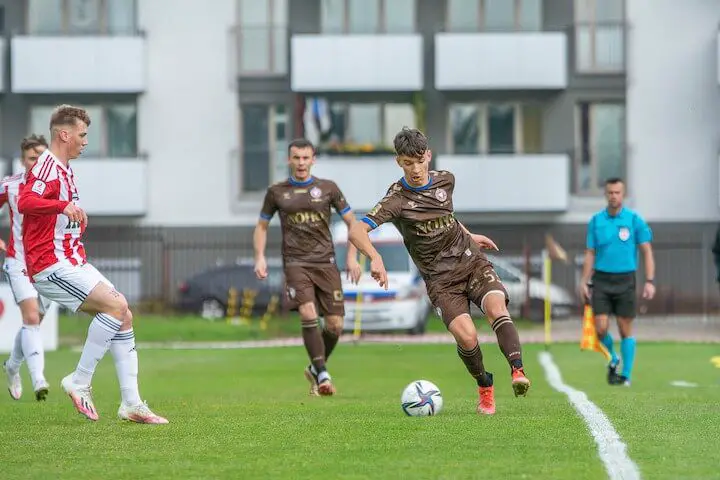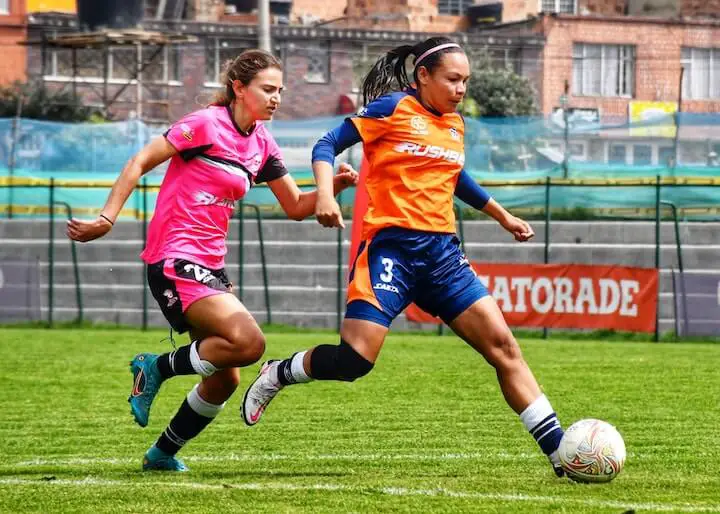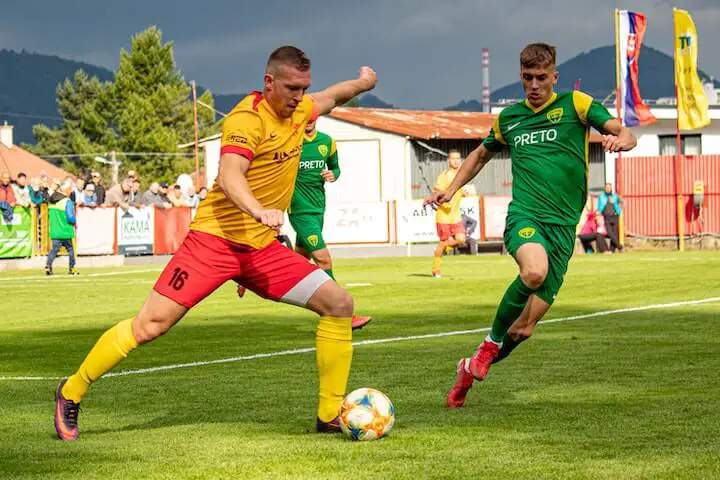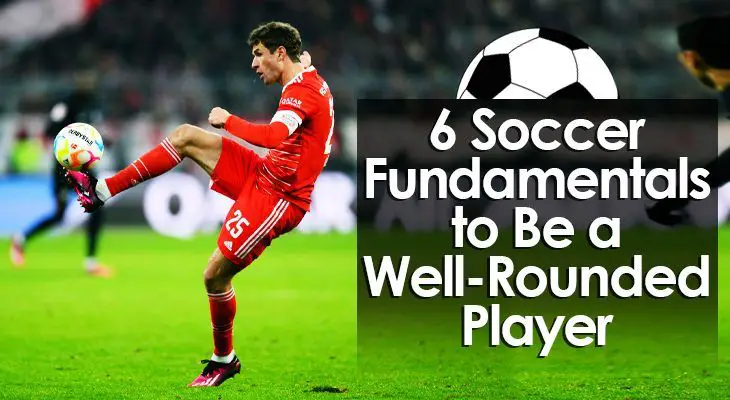6 Soccer Fundamentals to Be a Well-Rounded Player
Improving soccer fundamentals is the best way to become a well-rounded player.
With solid fundamental skills -- like passing, dribbling, and tackling -- you can build an excellent base level to build on in the future.
This article teaches you the 6 core soccer fundamentals you need to make massive improvements to your game.
Soccer Fundamentals to Master
#1 - Passing Technique
Passing is the most common on-the-ball action in soccer, with approximately 900 passes attempted in every game.
Unless you’re a goalkeeper in a very one-sided game, you’re likely to make several passes in any given match.
Learning good passing technique ensures you’re comfortable with the ball and have the confidence to find your teammates.
How to Improve Passing Technique
Passes come in a variety of forms.
From basic 5-yard passes, to more progressive through-balls to strikers.
Yet, in most cases, they require the same kicking technique:
Using backlift to generate momentum, the instep to make a firm connection, and follow through to execute with power and accuracy.
Your standing foot should be right next to the ball with your toes pointed toward the target.
The kicking foot is usually opened up, somewhere between a 45 and 90-degree angle.
Good passing technique means kicking the ball with your instep.
That way you get a maximum connection between the cleat and the ball, resulting in better accuracy, which is vital on a congested field.
Pro training tips:
Simple one-touch and two-touch passing drills or rondo exercises are the best ways to train the sidefoot technique.
Once it becomes second nature, start to practice using other parts of the foot -- like the heel, the outside of the cleat, or toe flicks.

#2 - First Touch and Ball Control
One of the most crucial soccer fundamentals is your first touch.
It dictates how much time you have in possession, what passing options are available, and your general chances of retaining the ball.
Interestingly, over half of all goals scored are one-touch finishes.
While a good first touch is vital for players in all positions, it’s particularly important for midfielders and forwards.
Seeing as they often receive passes with their back to goal or in tight areas, establishing control of the ball quickly allows them to hold onto possession and link up with teammates.
How to Improve First Touch
When receiving a pass, a player must have an idea of what they want to do with the ball.
If you’re in space, you’ll want to open up your body, allowing the ball to turn in the direction you want to go.
When shielding the ball from a defender, you should stand more square to the passer. This lowers your center of gravity and limits space for the opponent to get a touch.
Your first touch should either kill the ball’s momentum (trapping it at your feet), or change its trajectory into the space you want to go.
When a pass arrives at your feet, ensure you’re balanced and use the most appropriate foot (usually the one closest to the ball) to take a touch.
Pro training tips:
Practice two-touch and one-touch passes from different ranges with a teammate.
Don’t forget to train different parts of the foot and body, like the outside of your cleat, your thighs, chest, and head.
#3 - Footwork
Soccer players are known for being nimble, agile, and quick on their feet.
Although athleticism comes down to genetics, players can improve their footwork and agility.
Throughout a game or training session, players should be on their toes the majority of the time, rarely falling back on the balls of their feet. This helps develop strength and stamina to remain light-footed for extended periods.
Having good footwork is also important for positional play.
In any given match, a player is required to jog, sprint, slide, backpedal, or leap on the spot.
How to Improve Footwork
As with most soccer fundamentals, the key to improving your footwork is drilling and repetition.
Coaches should instruct their players to be "light on their feet" during training and use drills that work on this specific skill.
Ladder work, quick passing drills, rondos, and small-sided games are excellent examples of drills that improve footwork.
Pro training tips:
If you’re struggling with footwork, invest in an agility ladder and use ladder drills frequently between training sessions.
Having good balance is essential for improving footwork so another area to focus on in extracurricular training is your core strength.
Crunches, bridges, and planks are useful exercises for developing your core and they require no equipment.

#4 - Dribbling
One of the most exciting sights in soccer is a high-flying winger tearing down the sideline.
While dribbling is a core action in soccer, there can be a massive skill gap between players -- even at the professional level.
Some players, like Messi and Eden Hazard, excel with the ball at their feet, making it appear the ball is an extension of their body.
While defenders, and in particular, center backs, are generally slower and less mobile.
That said, all players must be competent on and off the ball so players will need a good base level of dribbling.
This applies to all players, whether you’re a defender running into space or an attacker taking on an opponent 1v1.
How to Improve Dribbling
Dribbling involves several soccer fundamentals that I’ve already discussed:
- First touch
- Ball control
- Footwork
It’s not an isolated skill as such, and since it’s performed on the move, it’s difficult to master.
The first step in improving your dribbling is to practice running in straight lines with the ball.
Next, add turns and direction changes into your training routines.
Finally, you can hone your craft by doing intricate dribbling drills such as cone weaves.
Ultimately, you’ll need to put your dribbling skills to the test in practice or games against real defenders.
Pro training tips:
Backyard training or kickabouts with friends are excellent ways to practice dribbling in a low-pressure environment.
The best dribblers in the game make it look easy, which comes down to hours of solo practice.
#5 - Tackling
The art of tackling is often overlooked as a key skill.
Many people wrongly believe that it simply comes down to strength and determination.
While both of these are important factors, tackling also involves:
- Intelligence
- Timing
- Technique
In the modern game, all players have their defensive responsibilities, from high-pressing forwards to steely center backs.
Poor tackling technique can lead to needless fouls, yellow cards, or defensive breaches.
How to Improve Tackling
The fundamental components of a good tackle are balance, quick feet, and timing.
Disciplined defenders jockey their opponents and focus on the ball, waiting for the right moment to stick in a foot to take the ball away.
If possible, get your body between the player and the ball to regain control.
Improving tackling can only be done in live scenarios either in a game or training session.
However, footwork and agility drills will benefit agility and sharpness which will impact your ability to tackle.
Pro training tips:
As a rule of thumb, avoid going to the ground (slide tackle) unless it’s absolutely necessary.
It’s also important to keep your eyes fixed on the ball rather than the dribbler's feet.
#6 Shooting
It’s no secret that shooting is one of the most important soccer fundamentals.
Whether you’re a left back or a number 10, you need to be ready and able to shoot if an opportunity arises.
Having good shooting technique and knowledge of how to strike the ball increases your chances of hitting the back of the net when the goal opens up.
How to Improve Shooting
Every player enjoys shooting practice, so it’s a skill you can harness quickly.
Situational training is one of the best ways to improve as it enables you to practice 1v1 finishing as well as shots from distance and different angles.
Depending on the situation, a different technique may be required.
For close-up accurate shots, the instep is generally the favored connection point.
However, when it comes to long-distance strikes, you may need to kick through your laces to generate enough power to beat the ‘keeper.
When you’re comfortable using these techniques, experiment with your weak foot or outside of the cleat shots.
Crafty strikers may also practice chip shoots, scooping the ball over a goalie when all other angles are closed off.
Pro training tips:
While it’s important to practice shooting in game-like situations, you should also work on more difficult techniques -- like volleys or shooting off the dribble.
If you don’t have goalposts to practice with, aim for specific points on a wall or fence.

Conclusion
To paraphrase the legendary Liverpool coach, Bill Shankly...
"Soccer is a simple game, complicated by idiots."
This expression has been said countless times by other managers and players...
And while it’s not entirely accurate, there’s a lot of truth behind it.
Mastering soccer fundamentals will make you a well-rounded player capable of playing in multiple positions.
If you’re struggling to make the impact you want, simplify your game and focus on technique.

